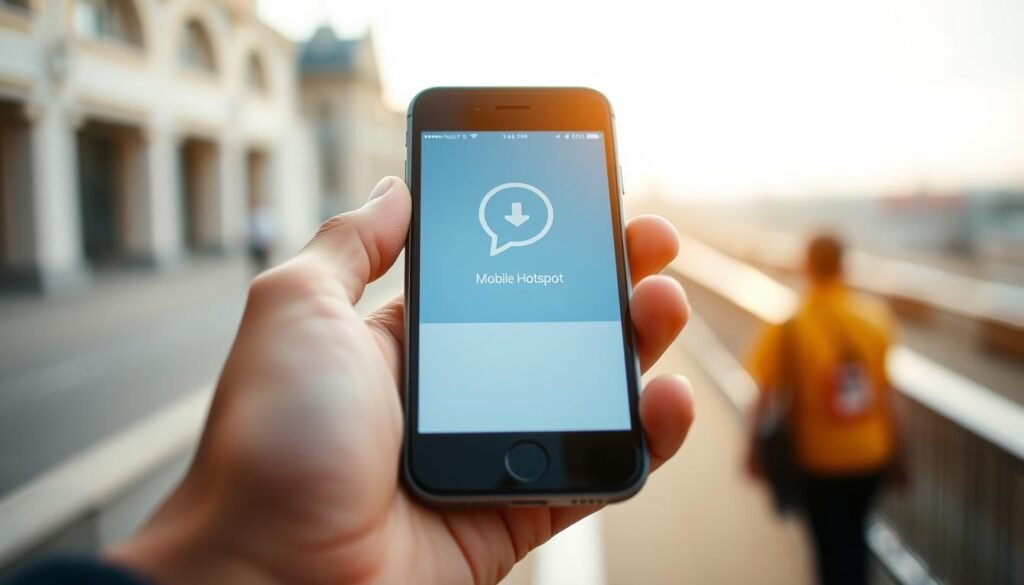Planning an international trip can be exciting, but it often comes with unexpected expenses—especially when it comes to your phone bill. Roaming charges can add up quickly, leaving you with a shocking bill upon return. Whether you’re navigating unfamiliar streets, translating languages, or booking hotels, your smartphone is an essential travel companion. However, these conveniences often rely on data connectivity, which can lead to hefty roaming fees.
Thank you for reading this post, don’t forget to subscribe!Understanding how to manage your phone usage abroad is crucial for cost-effective travel. Carriers like T-Mobile and Verizon offer international plans that can reduce these charges, but they might not always be the most affordable option. Local SIM cards or prepaid eSIMs are often more budget-friendly, providing ample data for your needs without the surprise fees.
In this article, we’ll explore detailed strategies to help you stay connected without overspending. From choosing the right plan to using Wi-Fi hotspots, we’ll cover it all so you can enjoy your trip worry-free.
Key Takeaways
- Roaming charges can significantly increase your phone bill when traveling internationally.
- Modern smartphones rely on data for essential travel apps, which can lead to extra fees.
- Planning your phone usage and choosing the right plan can save you money.
- Local SIM cards and eSIMs often offer more affordable data options than carrier plans.
- Using Wi-Fi hotspots and disabling data roaming can help avoid unexpected charges.
Understanding Roaming Charges and Their Costs
When you travel outside your home network’s coverage area, your phone connects to foreign networks, incurring roaming charges. These charges can add up quickly, especially if you’re using data, making calls, or sending texts. Understanding how these charges work is key to managing your phone expenses while traveling.
What Are Roaming Charges?
Roaming charges occur when your phone uses a foreign network. This happens when you’re outside your carrier’s coverage area. Your phone automatically switches to the local network, and your carrier bills you for this service. Charges typically apply to data usage, voice calls, and text messages.
Why Roaming Fees Can Be Expensive
Roaming fees can be high due to several factors. International tariffs, currency conversion fees, and infrastructure costs all contribute to the expense. For example, Verizon charges $10 per day for 2GB of high-speed data in over 210 countries, while AT&T offers a $10 daily plan with unlimited data, voice, and text. T-Mobile provides free service in limited areas but may charge for higher data speeds.
| Carrier | Plan Details | Cost |
|---|---|---|
| Verizon | 2GB high-speed data, unlimited 3G thereafter | $10/day |
| AT&T | Unlimited data, voice, and text | $10/day |
| T-Mobile | Free service in Canada and Mexico (2G/3G speeds) | Varying fees for higher speeds |
Understanding how these charges are structured is the first step in controlling your roaming costs. By knowing your carrier’s pricing and exploring alternative options like local SIM cards or eSIMs, you can avoid unexpected charges and stay within your budget.
How to avoid roaming charges abroad
Staying connected while traveling internationally doesn’t have to break the bank. With the right strategies, you can minimize roaming charges and keep your phone bill manageable. Whether you’re using your carrier’s travel plan or opting for a local SIM card, there are plenty of ways to stay connected without overspending.
Exploring Carrier Travel Plans and International Packages
Many carriers offer travel plans designed to reduce roaming costs. For example, Verizon’s TravelPass starts at $5 daily in Mexico and Canada, and $10 elsewhere, offering 2GB of high-speed data. AT&T’s International Day Pass provides unlimited data, voice, and text for $10 daily. These plans are convenient but may have limitations like data caps or reduced speeds after a certain threshold.
A key benefit of these plans is their ease of use—no need to change your SIM card or set up a new provider. However, they might not always be the most cost-effective option, especially for longer trips.
Local Carrier Options: eSIMs and Physical SIM Cards
Local SIM cards and eSIMs often provide better value for data, calls, and texts. eSIMs are particularly convenient, as they eliminate the need for a physical card and allow multiple profiles on a single device. Providers like Airalo and Ubigi offer affordable eSIM packages tailored for travelers.
Before choosing a local option, ensure your phone is unlocked and compatible with the local carrier’s network. This step is crucial to avoid any connectivity issues during your trip.
| Option | Cost | Data | Flexibility |
|---|---|---|---|
| Carrier Travel Plans | $5-$10/day | 2GB high-speed, then 3G | Easy to activate, no SIM change needed |
| Local SIM/eSIM | Varies by provider | Generous data bundles | Cost-effective, multiple profiles |
By comparing carrier plans with local options, you can choose the best fit for your travel needs, ensuring you stay connected without unnecessary charges.

Setting Up Your Mobile Service Before You Travel
Before embarking on your international journey, it’s essential to ensure your phone is ready for the trip. This preparation can save you from unexpected roaming fees and ensure uninterrupted connectivity.
Preparing Your Device and Verifying Unlock Status
First, check if your phone is unlocked. If it’s tied to a carrier through an installment plan, especially with AT&T or T-Mobile, it might not be unlocked. Verizon phones are typically unlocked. Visit your carrier’s store or contact customer service to confirm your phone’s status.
Navigate to your phone’s settings to manage data usage. On an iPhone, go to Settings > Cellular. For Android, visit Settings > Network & internet > SIMs. Here, you can disable data roaming to prevent unintended charges.
Scheduling International Data Plans in Advance
Consider purchasing an international data plan from your carrier. Verizon’s TravelPass and AT&T’s International Day Pass are popular options. These plans offer predictable costs and prevent bill shocks.
For longer trips, explore local SIM cards or eSIMs. Providers like Airalo offer affordable data packages. Ensure your phone supports eSIMs before purchasing. Prepaid SIM cards can be bought upon arrival at your destination.
Finally, confirm your international service with your carrier before departure. This ensures your plan is active when you land, avoiding any connectivity issues.
Alternative Strategies to Stay Connected Abroad
Exploring beyond traditional cellular networks can open up cost-effective and convenient ways to stay connected while traveling. Whether you’re navigating unfamiliar cities or staying in touch with loved ones, these strategies ensure you remain connected without hefty bills.
Using Mobile Hotspots and Tethering Solutions
Renting or purchasing a mobile hotspot provides reliable internet access abroad. Devices like Keepgo’s Lifetime Mobile Wi-Fi Hotspot offer data in multiple countries, starting at $129 for 1 GB. Tethering your phone’s connection to other devices is another option, allowing multiple gadgets to share data. However, tethering may reduce your phone’s battery life and could be limited by your carrier’s data caps.
Maximizing Free and Secure Wi-Fi Access
Free and secure Wi-Fi is widely available in hotels, cafes, and public spaces. Using a VPN on public networks enhances security. Apps like WifiMapper and Instabridge help locate nearby hotspots, making it easier to stay connected without data. Prioritizing Wi-Fi for heavy usage, like streaming, can significantly reduce data consumption.

Carrying a portable charger ensures your hotspot or phone stays powered throughout the day. While these methods may require initial setup, they often offer better value and flexibility compared to traditional roaming plans.
Cost Comparison: Evaluating International Options for Data, Calls, and Texts
When traveling internationally, staying connected comes at a cost. Understanding the options can help you choose the most cost-effective plan for your needs.
Carrier Travel Plans vs. Local SIM/eSIM
Carrier travel plans like Verizon’s TravelPass and AT&T’s International Day Pass offer convenience but may not always be the cheapest. For shorter trips, these plans provide predictable daily costs. However, for longer stays, local SIM cards or eSIMs often offer better value with more data at lower prices.
| Option | Cost | Data | Flexibility |
|---|---|---|---|
| Carrier Travel Plans | $10-$25/day | 2GB high-speed, then reduced speed | Easy activation, no SIM change needed |
| Local SIM/eSIM | $10-$30 | Generous data bundles | Cost-effective, multiple profiles |
| Mobile Hotspot | $129+ for 1GB | Varies by provider | Reliable but higher upfront cost |
Estimated Costs and Scenarios
For a week-long trip, a carrier plan might cost $70-$175, while a local SIM could be $10-$30. If you’re in multiple countries, eSIMs offer flexibility without swapping cards. Mobile hotspots are great for groups but have higher initial costs.
In conclusion, comparing options based on your travel length and data needs can save you money. Local SIMs and eSIMs are often more cost-effective for longer trips, while carrier plans are better for short stays.
Conclusion
Traveling internationally can be seamless and cost-effective with the right approach to managing your phone usage. Roaming charges can add up quickly, but by understanding your options, you can stay connected without overspending. Whether you choose a carrier travel plan, a local SIM card, or an eSIM, each option offers unique benefits that can suit your travel needs.
Preparation is key. Before your trip, ensure your phone is unlocked and compatible with international networks. Research and compare the costs of different plans to find the most economical choice for your stay. For shorter trips, carrier plans like Verizon’s TravelPass or AT&T’s International Day Pass offer convenience and predictable costs. However, for extended travels, local SIM cards or eSIMs often provide more data at lower prices.
Don’t forget to explore alternative connectivity options like mobile hotspots or Wi-Fi access. Using free and secure Wi-Fi in hotels, cafes, and public spaces can significantly reduce your data usage. Additionally, disabling data roaming on your phone and utilizing Wi-Fi calling can help prevent unexpected charges.
In conclusion, staying connected while traveling doesn’t have to be costly. By combining proper device preparation with smart purchasing decisions, you can enjoy your trip with peace of mind. Review your current mobile plan before departure and consider upgrading to an international plan or purchasing a local SIM card. With these strategies, you’ll be well-prepared to navigate your destination without worrying about your phone bill.

